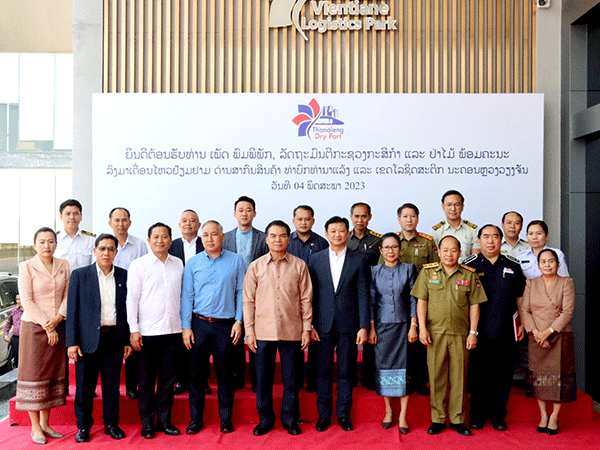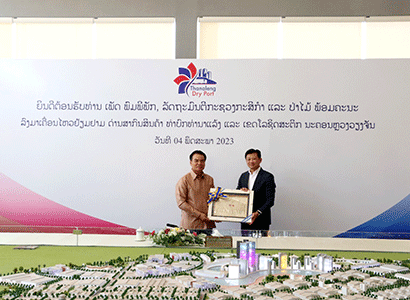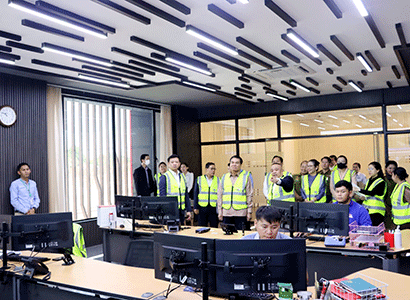 |
| Dr Phet Phomphiphak (front, fifth left), Mr Chanthone Sitthixay (fifth right) and other representatives of both sides gather for a group photo. |
Thanaleng Dry Port could generate US$200 million
a year for the state from container fees, developer says
Thanaleng Dry Port plans to introduce a fast-track lane to speed up the movement and transit of agricultural produce between S.E. Asia and China.
Thanaleng Dry Port (TDP), Laos’ first ever integrated logistics centre, has the potential to earn the state as much as US$200 million a year from container fees once it is fully maximised, its developer has said.
But to fulfil this revenue potential, procedures must be streamlined at the dry port, which facilitates cross-border rail freight transport, to speed up the movement of freight, especially farm products.
“Rail transport is a new service that currently has many duplicated inspection procedures,” Chanthone Sitthixay, Chairman of the Vientiane Logistics Park Co., Ltd. – the developer of the dry port - told Minister of Agriculture and Forestry Dr Phet Phomphiphak on Thursday.
He also informed the minister, who visited the multimodal transport hub in Vientiane that day, that his ministry plays a key role in facilitating the transit of farm produce.
 |
| Mr Chanthone Sitthixay (right) presents a gift to Dr Phet Phomphiphak. |
The chairman proposed setting up a one-stop clearance service at the dry port, which is a vital trade gateway between Southeast Asia and China.
“To achieve the US$200 million figure, we need to address [streamline] immigration, customs and agriculture-related procedures,” Mr Chanthone said.
 |
| Dr Phet Phomphiphak visits the dry port control room. |
He added that his company is currently working with immigration and customs authorities to introduce a fast-track green lane to speed up the movement of agricultural produce, which constitutes a significant amount of the goods traded between Asean and China.
In addition, the dry port operator is working with the Chinese side to build a Chinese-certified sanitary and phytosanitary (SPS) centre at the dry port-associated Vientiane Logistics Park to certify goods traded between China and its partners.
Construction of the centre is expected to begin in July, and will take about five months to complete. Once the SPS centre is operational, products labelled with SPS customs seals there can directly enter the Chinese market without having to undergo SPS checks at the Chinese border, Mr Chanthone said.
These facilities and services are essential to handle the growing trade and freight transport in the region.
In 2022, China and Asean recorded two-way trade amounting to US$970 billion. Of this, trade in agricultural produce accounted for up to 25 percent of the total.
The value of all exports from Thailand to China reached about US$70 billion, of which more than half was agricultural produce.
However, only 2 percent of all agricultural produce was shipped to China by rail. Most was transported by sea and land, despite the fact that rail transport is a highly cost-effective option, Mr Chanthone said.
He cited the complicated inspection procedures and the newness of the rail freight service as the main reasons for lack of use of the railway.
But given the cost-effective option offered by rail transport, coupled with the improvement of bureaucratic procedures, the dry port operator is optimistic that there will be a steep rise in the amount of freight passing through the dry port.
It is estimated that at least one million containers could pass through the dry port annually in the years to come if all of the above-mentioned services and facilities are put in place. The government charges a fee of US$200 for each container that passes through the dry port.
“The government can earn US$200 million from these fees alone,” Mr Chanthone reiterated.
Dr Phet praised the Lao investor’s determined efforts to develop the dry port, which has greatly improved Laos’ logistics and transport links to regional and global markets.
In response to Mr Chanthone’s proposal, the minister said “There are many aspects of the existing logistics system and associated transport that we have to work together to study.”
He agreed on the need to expedite services to maximise revenue potential.
Thanks to the operation of the dry port and railways, export and import service providers are benefitting from reduced transport costs.
Panya Paputsaro, President of Thailand’s Kaocharoen Train Transport Co., Ltd., told Vientiane Times that shipment by rail enables his company to cut transport costs by 30 percent. Travel time is also shortened by about half compared to land transport, thus delivering fresher seasonal Thai fruit to Chinese consumers.
Opening for service in December 2021, the dry port, which houses extensions of the Laos-Thailand and Laos-China railways, handled 41,000 containers last year, which generated about 30 billion kip for the state budget. It is expected that the container volume could double this year.
The Vientiane Logistics Park Co., Ltd. is also developing a world-class logistics complex comprising seven zones, including an export processing zone where investors can set up facilities such as cold-chain storage warehouses to keep farm products fresh.
The US$727 million dry port and logistics complex is part of the packaged Lao Logistics Link project, which also includes the Vung Ang seaport in Vietnam’s Ha Tinh province and a planned railway linking the seaport to the dry port in Vientiane and a logistics park in Khammuan province through which the planned railway will run.
Once it is fully realised, the Lao Logistics Link will be a big boost to the government’s efforts to transform landlocked Laos into a land-link country.
By Advertorial Desk
(Latest Update May 7, 2023)
|